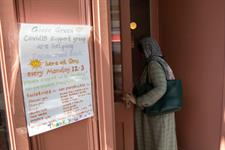The coronavirus outbreak has seen the rise of a new phenomenon: mutual aid groups. These groups of people offering help and support to their neighbours have sprung up seemingly overnight, often operating on a hyper-local, street-by-street basis.
There are currently more than 4,250 mutual aid groups in the UK, with the smallest consisting of just a handful of members and the largest comprising more than 1,000.
The enormous groundswell of enthusiasm for volunteering in all its different forms has been one of few positive things to come out of the pandemic, but what does the rise of mutual aid, which has deliberately distanced itself from the traditional voluntary sector, mean for charities? What can they learn from it and how can the two work together during the crisis and beyond?
Anna Vickerstaff, a coordinator at Covid-19 Mutual Aid UK, which supports the local groups, says she believes the huge response to mutual aid has been driven partly by people’s desire for agency at a time where it’s easy to feel helpless, but also by a fundamental sense of solidarity in a crisis.
The groups are run informally. There is no hierarchy or steering group and Mutual Aid UK is there to offer advice and resources, but not direction. Vickerstaff says this allows the groups to stay rooted in their communities and avoid the power dynamics between benefactor and beneficiary that often bog down the formal charity sector.
“It’s much more of a circular building of community that recognises the different skills and needs and how things can be built together as a unit rather than creating a one-way flow of help,” she says.
“All of these groups have been organising autonomously within their communities and it’s about what works for them in their locations.”
Too often, Vickerstaff says, the charity sector has failed to harness existing expertise and lived experience within a community when trying to solve problems, whereas the mutual aid model, which has its roots in black radical, anarchist and sex-worker campaigns, amplifies and empowers those voices.
“You can learn a lot about community resilience from people who have had to build those communities in the face of racial and economic injustice for decades,” says Vickerstaff.
“Coronavirus is putting a magnifying glass on existing injustices at a national level and highlighting who are the most vulnerable at local level. I hope the community structures being built or emboldened at the moment will outlast the pandemic and continue to challenge those injustices.”
The lack of formal structures involved in mutual aid does raise questions about accountability and safeguarding, but Vickerstaff seems confident that this can be handled effectively at a local level.
“Covid-19 Mutual Aid UK is not responsible for any of the local groups,” she says.
“I think self-organising communities know how to care for people within those communities. It’s just the technical details they need support with. It’s not about spoon-feeding instructions to these groups, but providing resources to support them.”
Where there have been questions about money-handling and safeguarding, she says, mutual aid has reached out to more established organisations, including charities, for advice and to help draw up guidelines for mutual aid groups to follow if they have concerns.
But Vickerstaff adds that the model’s strength lies in its autonomy. Charities can amplify the work of mutual aid groups and provide guidelines and resources, something many are already doing. But she says it’s important the relationship remains one of collaboration, not co-option.
Paul Reddish, chief executive of the volunteering charity Volunteering Matters, says he respects this stance, but adds that any collaborative relationship needs to be two-way.
Mutual aid can help to ease the burden on charities by completing simple tasks for people and unearthing issues that charities need to deal with. But Reddish says there are issues that people might not be aware their neighbours are facing or are equipped to handle themselves.
For example, he says, although the needs of an elderly person who can’t get out easily might be very visible to their neighbours, the needs of someone who has just come out of prison or the care system are likely to be hidden and more complex.
“The neighbourliness fostered by mutual aid scrapes the surface of charity but doesn’t go into the depths,” Reddish says. “Delivering a food parcel is one thing; knocking on the door and discovering that someone hasn’t got out of bed for a week is another.”
But that’s a discussion for after the crisis, he adds.
“Until there’s not a single person going hungry, it doesn’t matter,” he says. “Let’s just throw all our resources at it now. We shouldn’t be getting precious about who’s doing what.
“This crisis would be a hell of a lot worse without mutual aid groups. The sector has a huge amount to be thankful for.”
